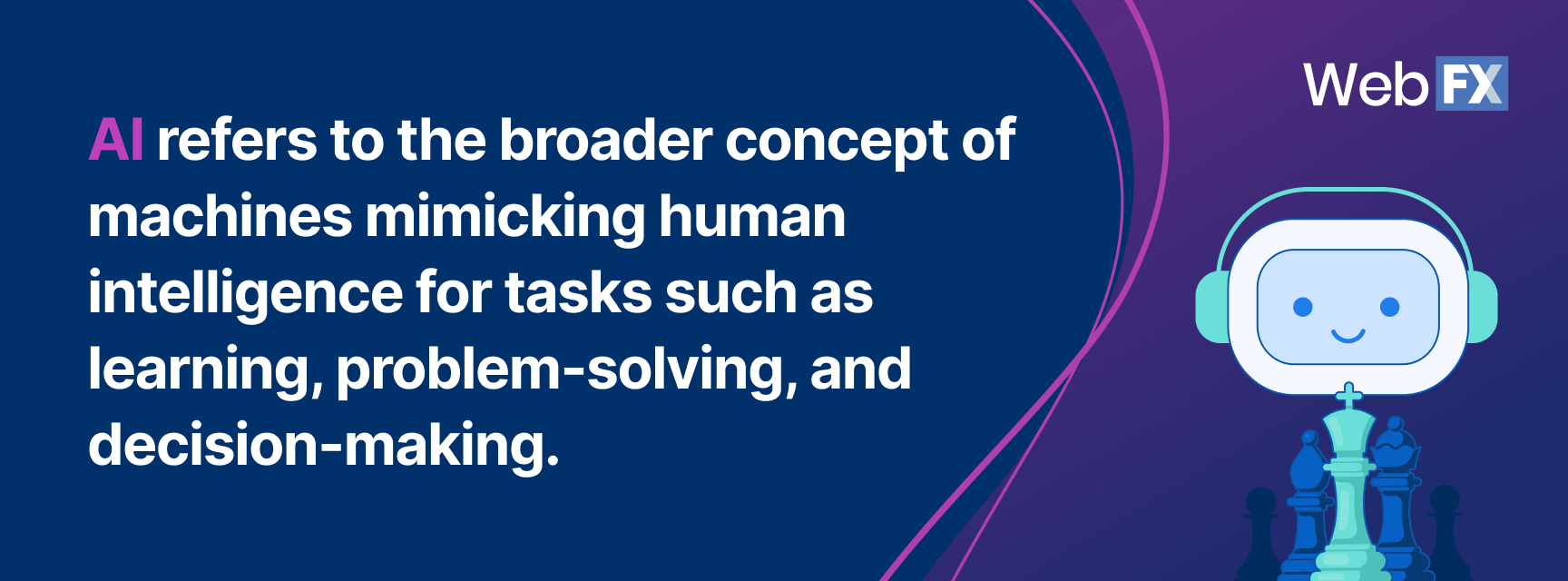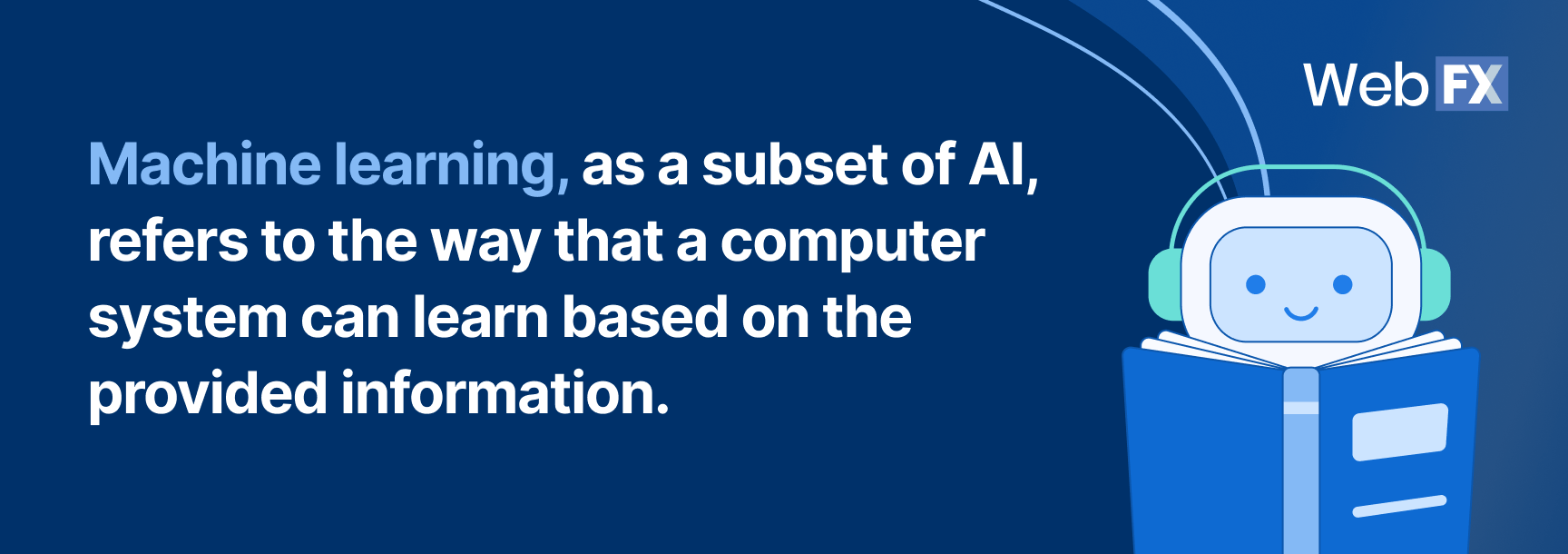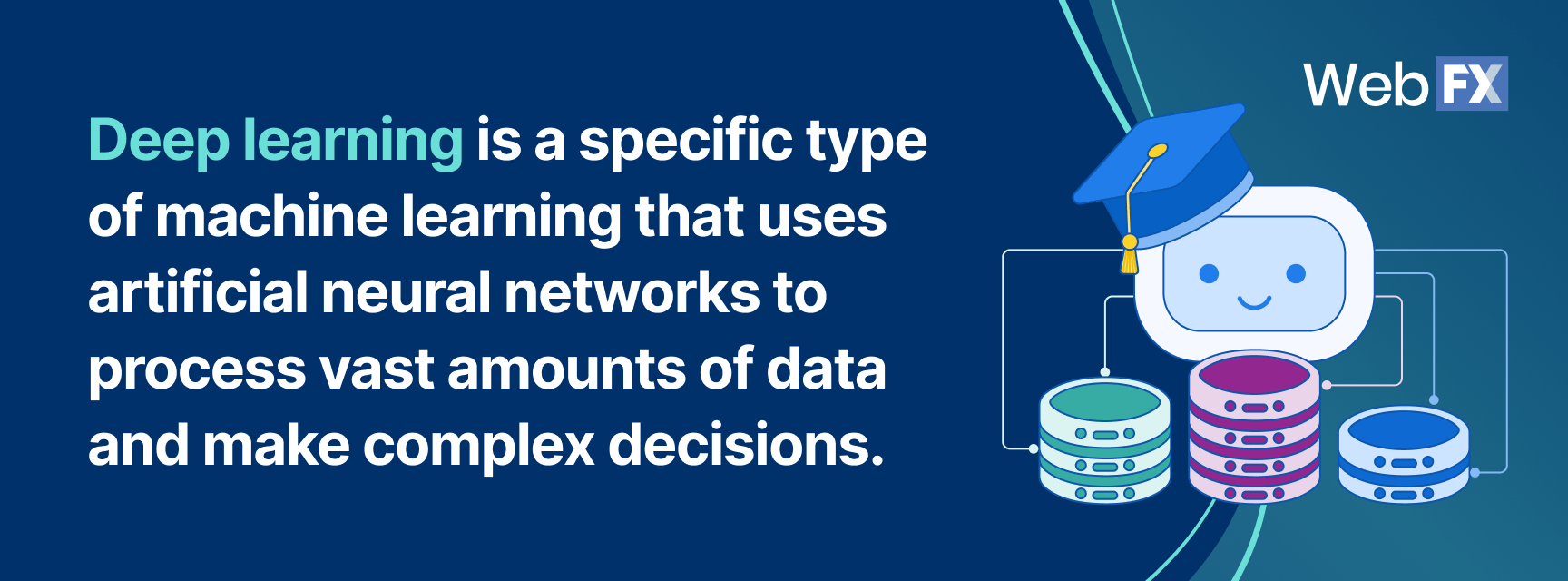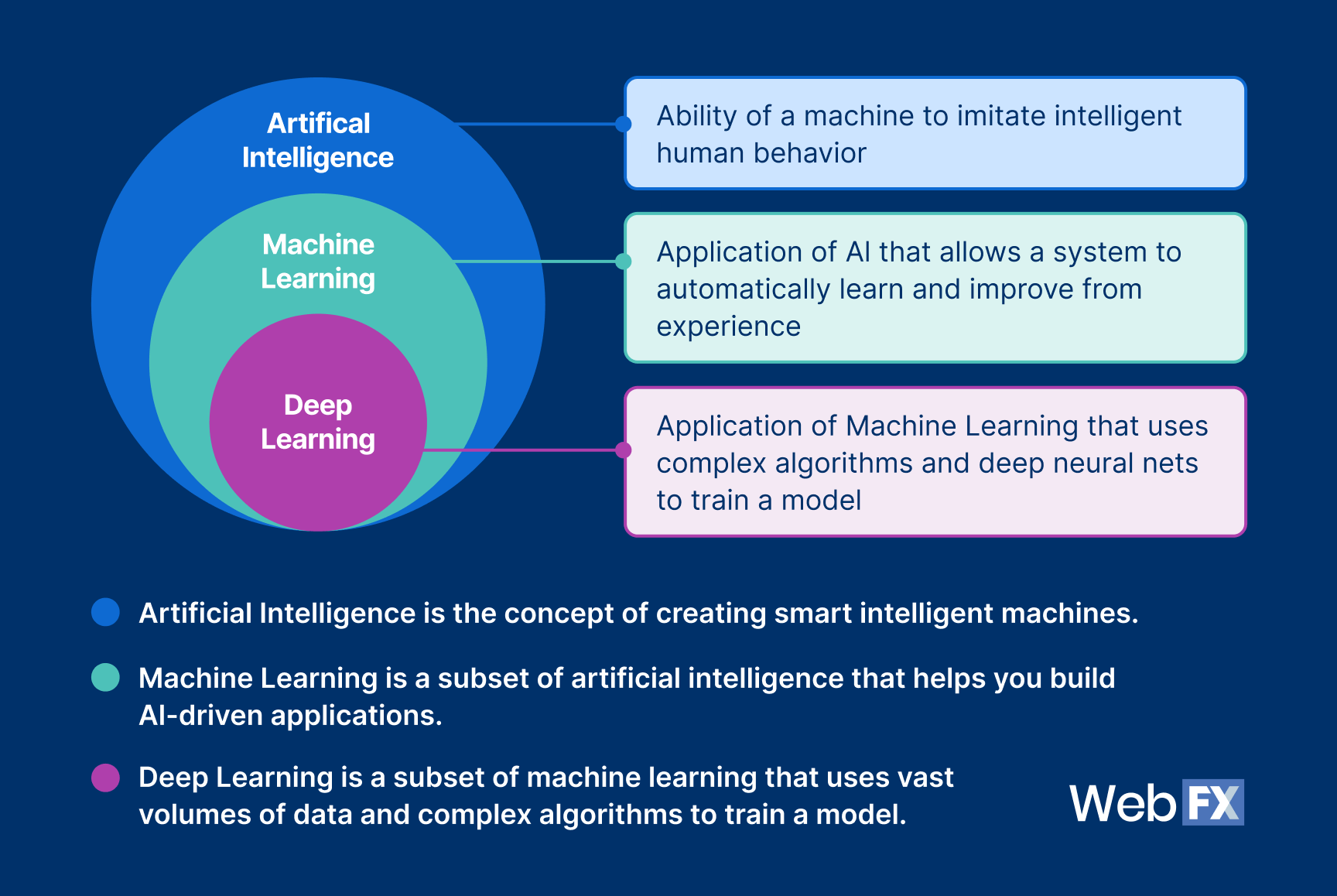-
 Published: Apr 17, 2025
Published: Apr 17, 2025
-
 8 min. read
8 min. read
-
Summarize in ChatGPT
-
 Sam Wixted
Sam Wixted Content Writer
Content Writer
- Sam has been writing for WebFX since 2016 and focuses on UX, crafting amazing website experiences, and digital marketing In her free time, she likes to spend time on the beach, play with her cats, and go fishing with her husband.
- What is artificial intelligence (AI)? AI refers to machines mimicking human intelligence for tasks like learning, problem-solving, and decision-making by training them with algorithms — a list of rules that teach the machine how to react in specific situations using “if/then” style information.
- What is machine learning? Machine learning is a subset of AI that enables systems to autonomously learn and enhance performance based on experience without explicit programming, requiring large amounts of data to identify patterns and understand likely outcomes.
- What is deep learning? Deep learning is a specific type of machine learning that uses artificial neural networks to process vast amounts of data and make complex decisions independently — it can make conclusions on its own without much previous training, unlike standard machine learning.
- How do AI, machine learning, and deep learning relate to each other? These three concepts fit together like a target — AI is the outermost ring representing the overarching field, machine learning is the middle ring as a specific type of AI, and deep learning is the innermost circle as a further subset of machine learning.
- What are the main limitations of these technologies? AI lacks understanding and common sense, machine learning tools are limited to their training data and can’t reason beyond it, and deep learning requires massive amounts of data, time, money, and resources that many companies don’t have — plus it comes with high environmental costs.
If you’re confused by artificial intelligence, machine learning, and deep learning, you’re not alone. Often, these terms get used interchangeably, but they’re not the same thing — though they belong in the same family, they are all different in their own way.
AI vs. machine learning vs. deep learning — we’ll go over the definition and uses of each term, including how they work together, below:
- What is AI?
- What is machine learning?
- What is deep learning?
- AI vs. machine learning vs. deep learning: What’s the difference?
- How AI, machine learning, and deep learning fit together
- Limitations with AI, machine learning, and deep learning
Want to learn more about using tech in marketing and advertising? Sign up for our newsletter today and get insights right in your inbox!
What is AI?

AI refers to the broader concept of machines mimicking human intelligence for tasks such as learning, problem-solving, and decision-making.
But how does AI work exactly? For a machine or computer to be artificially intelligent, you have to train it with algorithms, or a list of rules and regulations. An algorithm is fundamental to training a computer or machine to be AI-equipped.
In this list of rules, you train your machine what to do if “something” happens. Providing “if/then” style information to a machine teaches it how to react if a particular situation arises, and the longer it’s exposed to those “if/then” situations, the better it’ll become at solving them.
Example of AI
A simple example of artificial intelligence at work would be bot marketing via a chatbot on a website or Siri on your smartphone. These applications prove that machines can be trained to act like humans to accomplish a specific task.
Keep in mind that artificial intelligence is the biggest, overarching group when talking about machine learning vs. AI vs. deep learning. That means everything classified as machine learning or deep learning is a part of artificial intelligence.
Our tool, RevenueCloudFX is another example of an AI content tool. This marketing automation suite utilizes artificial intelligence to bring amazing results to businesses marketing and advertising online. It can provide clients’ businesses with data-backed recommendations when it comes to their marketing strategies.
Bonus Read: Artificial Intelligence vs. Human Intelligence
What is machine learning?

Machine learning, a subset of AI, refers to the way that a computer system can learn based on the provided information.
Machine learning enables systems to autonomously learn and enhance their performance based on experience without any explicit programming. It is centered around creating computer programs that can process and utilize data to self-learn.
The goal of machine learning is to train a machine to know what to do in a specific situation based on the data provided. So, to train a machine with machine learning, you’ll have to provide it with large amounts of data. A computer picks up on patterns and trends in the data you give, which allows it to learn and understand the most likely outcomes.
Types of machine learning
There are three main types of machine learning, which describe the algorithms used to train each machine learning tool. Those three types are:
- Supervised learning: In this situation, models are trained with labeled data, which means they already know the target variable. If you show a model 1,00 pictures of trees and note that they are trees, the tool will be able to identify a tree.
- Unsupervised learning: Conversely, in unsupervised learning, models identify patterns in unlabeled data. The model learns to find the patterns within the data, which makes it easier to detect patterns moving forward.
- Reinforcement learning: With reinforcement learning, models learn through rewards and penalties. This learning process requires much trial and error for the model to learn patterns in an unstable environment.
Example of machine learning
Say there’s a conveyor belt at a factory that separates glazed doughnuts from doughnut holes. When operators trained the belt with machine learning, they probably fed it data that looks something like this:
- Left belt: 2-5 oz.
- Right belt: 5-10 oz.
- Left belt: 1 unit
- Left belt: 5+ units
The doughnuts would then be sorted based on this data.
However, if a doughnut entered the belt that was 12 oz, the machine wouldn’t know what to do since that wasn’t a part of its training. That’s where deep learning comes in.
What is deep learning?

Deep learning is a specific type of machine learning that uses artificial neural networks to process vast amounts of data and make complex decisions Deep learning enables tools to accomplish tasks such as classification, regression, and representation learning.
Deep learning is a “deeper” subset of teaching machines with the provided information. While you must feed a machine data for machine learning to work, deep learning can make conclusions on its own.
Types of deep learning architectures
To train deep learning models, there are two different architectures that programmers use:
- Convolutional neural networks (CNNs): Used in image and video recognition. CNNs work best with spatial data for things like facial recognition and video classification.
- Recurrent neural networks (RNNs): Used in natural language processing (NLP) and time series analysis. RNNs work best with sequential data for things like stock prices, temperatures, and sentences.
Example of deep learning
Let’s say you have a cat feeder that you have trained via machine learning to dispense food when you speak any phrase with the word “feed.”
But what if you say “The cats are hungry” instead?
With machine learning, the food dispenser wouldn’t react, but if a user trained the cat food dispenser with deep learning, it would be able to compute the meaning of your sentence to work the device.
AI vs. machine learning vs. deep learning: What’s the difference?
Now that we know about AI, machine learning, and deep learning, we can start comparing the three tools. This table breaks down the differences between them.
| Aspect | AI | Machine learning | Deep learning |
| Definition | Tool for simulating human intelligence | Subset of AI focusing on learning from data | Subset of ML using neural networks |
| Data requirements | Can work with small or large amounts of data | Moderate — at least ten times as many data points as there are features in your dataset | Requires large datasets |
| Human intervention | High | Moderate | Low |
| 2025 use case | AI today focuses on content generation (text, images, videos) | Machine learning techniques are essential for tuning and improving AI outputs | Deep learning powers transformer models like GPT-4 |
| Example | Virtual assistants like Alexa | Netflix’s recommended watch engine | Self-driving cars using CNNs |
How AI, machine learning, and deep learning fit together
AI vs. machine learning vs. deep learning: What’s the difference?
If every term has a different definition, how do they possibly fit together? The best way to connect and compare AI vs. machine learning vs. deep learning is to think of a target.

The outermost ring of the target illustrates artificial intelligence. AI is the overarching term that refers to the way that machines can be as smart as humans — and sometimes even smarter.
Machine learning, then, is the middle ring of the target. It’s a specific kind of artificial intelligence, and it refers to the way that you train computers (machines) to act like humans.
The innermost circle is deep learning, which is a further subset of machine learning. It can do even more than machine learning, and can essentially make decisions without much previous training. It’s best to think of AI vs. machine learning vs. deep learning as different subsets that are a part of the same family — each with its own importance.
Limitations with AI, machine learning, and deep learning
While AI is transforming the way we create content, market our businesses, and even diagnose illness, there are limitations to any model.
AI, for one, lacks understanding and common sense. There are plenty of ChatGPT fails that showcase the lack of understanding and limitations of AI generators and chat tools.
Machine learning tools are also limited to the data they are trained on. Unlike deep learning, they can’t expand their data points and reason.
And, even though deep learning is a powerful tool, it comes at a high cost — monetarily and environmentally. It takes massive amounts of data, time, money, and resources to invest in deep learning models, which many companies don’t have.
Activate AI in your marketing campaigns
If you’re still curious about the inner workings of machine learning vs. deep learning vs. AI, we understand! These terms can be challenging to differentiate, but we’re here to help.
WebFX knows AI so much that we’ve developed proprietary marketing software, RevenueCloudFX, which we use to supercharge our clients’ campaigns and their results. So far, we’ve helped our clients’ businesses earn more than $10 billion in revenue — and that’s only in the past five years.
To learn more about RevenueCloudFX and how it can use artificial intelligence to improve your marketing strategy, be sure to contact us online or give us a call at 888-601-5359!
-
 Sam has been writing for WebFX since 2016 and focuses on UX, crafting amazing website experiences, and digital marketing In her free time, she likes to spend time on the beach, play with her cats, and go fishing with her husband.
Sam has been writing for WebFX since 2016 and focuses on UX, crafting amazing website experiences, and digital marketing In her free time, she likes to spend time on the beach, play with her cats, and go fishing with her husband. -

WebFX is a full-service marketing agency with 1,100+ client reviews and a 4.9-star rating on Clutch! Find out how our expert team and revenue-accelerating tech can drive results for you! Learn more
Try our free Marketing Calculator
Craft a tailored online marketing strategy! Utilize our free Internet marketing calculator for a custom plan based on your location, reach, timeframe, and budget.
Plan Your Marketing Budget

See AI Marketing in Action
Explore how WebFX helped a regional brand get discovered in AI search experiences — proving what’s possible with today’s AI-driven marketing!

Proven Marketing Strategies
Try our free Marketing Calculator
Craft a tailored online marketing strategy! Utilize our free Internet marketing calculator for a custom plan based on your location, reach, timeframe, and budget.
Plan Your Marketing Budget




